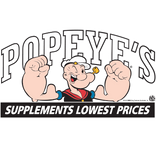
A Beginners Guide to Muscle Building
Our latest Blog contributor hails from downtown Toronto! Kalan Malan has been working at Popeye's Supplements for over 6 years, helping customers achieve their goals and make the best choices in their fitness path. With a passion for weightlifting, he truly enjoys helping others with their health and athletic pursuits. Today's article is his first on our site as he offers some great starting points for those new to lifting and a desire to grow during this season of gainzzzz!
Intro
Starting out in the gym can be very intimidating. There is so much to know and learn that figuring out where to start on your fitness journey may feel impossible. This is why your good friends at Popeye’s are here to help start you off right on your journey with our Beginner’s Guide to Gaining Muscle.
In this blog we will be examining the mechanisms of building muscle, and the variables that you can control to help maximize your muscle growth.
Protein - Let's Start with some fun!
It’s a little bit of a meme that bodybuilders love protein, (click that link for a good laugh) however this stereotype doesn’t come from nowhere. At its most base explanation, building muscle is done by a combination of doing two things. Lifting weights and eating protein. When you lift weights your body triggers an adaptive response, where your muscles effectively go “wow that was hard, let’s get bigger to make that easier next time.”
To achieve this goal, your muscles use amino acids, which are the foundational building blocks of muscle. The amino acids used to build muscle are found in protein. The widely regarded rule of thumb is for people to consume roughly 0.8-1 grams of protein per lb of bodyweight to build muscle.[i]
There are many great sources of protein that you can easily incorporate into your already established eating patterns. Adding high protein foods such as chicken or fish to your meals is an easy way to boost your protein intake throughout the day. Adding protein shakes and high-protein snacks such as protein bars are also a great way to conveniently supplement extra protein with a fantastic amino acid profile into your day.
Workout Volume
Now, when planning out your workouts, you may find yourself asking “how much should I workout?” This is known as your workout volume, and it is made up of a few key factors.
The variables that make up volume are reps and sets. A repetition (rep) is one completion of an exercise, such as one push-up or one arm curl. So, if you do a bicep curl, using a full up and down motion 8 times, that is 8 reps in one sitting. These 8 reps make a set. For example, if you do 8 reps of bicep curls 4 times, that is 4 sets.
Interesting Fact: While performing a rep, eccentric, or negative, action refers to the lengthening of a muscle, as when you lower the weight or allow a machine to retrieve the bar. Muscles respond best when a rep’s negative is not rushed, so be sure to squeeze and have a moderate tempo during your rep’s negative. A good tempo to use is to spend twice as much time on your negative as you do on your positive. Results are not just about the amount of weight of an exercise, but your form, tempo and pump.
When working out for muscle building you are aiming for the volume that will lead to muscle hypertrophy, which is simply an increase in muscular tissue. Studies have shown that getting roughly 15 to 20 sets per muscle in a week is ideal for stimulating hypertrophy. For a workout this might look like doing 4 sets of 4 exercises for a total of 16 sets across the entire workout to hit this volume goal.
For the number of reps that you should do per set, the traditional wisdom is to do between 6 to 12 reps per set.[ii] While you can make gains in rep ranges above and below the 6 to 12 range, this rep range tends to be ideal. It helps prevent the stress of heavier weights associated with lower rep ranges, and allows for shorter, more effective, recovery times than higher rep ranges.
Workout Intensity
You’ve arrived at the gym; you’re keyed up on your favourite pre-workout and you’re ready to lift some weights. The question is, how hard should you be pushing throughout your workout?
Effort is maybe one of the most important training variables. How hard you push is directly correlated with the results you get from your training sessions. However, this doesn’t mean that to see muscle growth you must be training to failure on every single set. For the most part, pushing yourself hard enough that you are roughly 2-3 reps away from failure during your working sets is an optimal amount of effort for gaining muscle.[iii] This helps prevent injury and promote recovery while still promoting growth.
Now, knowing what weight you must lift to achieve this level of effort may seem difficult. There are multiple ways to determine what weight you should be lifting. Two very popular methods to know how heavy you should be lifting are progressive overload and RPE.
Progressive overload is a simple method of seeing continued growth. The effective idea of progressive overload is to gradually increase the weight every workout. For instance, if you completed your heaviest set of squats at 135lbs, the next week you might add another 10lb plate on each side and squat 155lbs. Then, so on and so forth you add weight to see sustained growth and continued progress. If you are lifting for the first time or after a 3 week or more break, consider starting light to delay the intense muscle soreness referred to as Delayed Onset of Muscle Soreness or DOMS. DOMS is counterproductive and painful.
Now, the main problem with progressive overload is at a certain point you just can’t add any more weight. This is where incorporating RPE in your workouts becomes important. RPE stands for ‘Rate of Perceived Effort’. Lifters who incorporate RPE effectively take a moment after each set and rate the difficulty of a set on a scale of 1 to 10. Aiming for an RPE of 7-9 tends to be the most popular level of intensity to promote muscle growth.
Rest
Rest is one of the most important factors to consider when building muscle. Getting an appropriate amount of rest between sets is key to seeing muscle growth.
A general rule of thumb for rest times is between 1-3 minutes to maximize growth.[iv] Allowing your muscles an appropriate amount of time to rest allows you to push harder and maximize the results you see from your training. Depending on how you’re training this may look like allowing you to lift heavier weights or allowing you to perform more reps. Generally, the larger the muscle part that was just worked, the more rest time is needed.
The role of sleep, in muscle building is also massively important. Getting deep, restful sleeps allows your body more opportunity to repair and heal. Helping ensure that your muscles are replenished and ready to tackle your next workout.
Supplementation
There are many ways in which supplements can aid you in your muscle-building journey. Some of the best supplements that you can take for muscle building include supplements that aid in performance enhancement, recovery, as well as diet.
Two of the most popular performance enhancing supplements are pre-workouts and creatine. Pre-workouts allow you to increase the intensity of your workouts by giving you more energy. They often also include ingredients such as beta-alanine that increase muscular endurance[v] and l-citrulline which aids in increasing blood flow.[vi]
Creatine aids your body in the production of ATP[vii] which is what fuels all work done by the muscles. Allowing you to gain strength faster and maximize returns on your workouts.
For help with recovery many people turn to glutamine and natural sleep-aids. Glutamine is one of the most abundant amino acids in the body. Supplementing with glutamine has been shown to help with lessening muscle damage, allowing athletes shorter recovery times.[viii]
Sleep-aids do exactly what the name implies. They aid in helping you fall asleep as well as get a deeper, more restful sleep. They often contain ingredients such as melatonin, GABA, and 5-HTP. All supplements which have proven effects for increasing sleep quality.[ix] [x] [xi]
To optimize your diet, protein powders and mass gainers are a cost effective, high quality and convenient way to feed your muscles. Protein powders simply put, increase your protein uptake and help you reach the optimal amount of protein you need to consume in a day for muscle gain.
Mass gainers serve a similar purpose as protein powders do. However, instead of just helping you increase your protein intake, they help you reach your overall caloric intake goals by giving you large amounts of carbs and some fats as well. Mass Gainers help build mass the fastest, but if it’s a lean body that you are after consider using just a Protein Powder only or a combination of a Protein Powder and Mass Gainer. Limit your Mass Gainer to immediately after your workout when carbs and calories are needed most. Individuals looking for Mass, can also use their Mass Gainer before bed and/or for breakfast.
Go Forth and Achieve Your Goals
With the knowledge that you now have in hand, it is now time to hit the gym, get a killer workout and maximize your gains to the fullest potential. Don’t forget to come back and visit our blogs for more info to help you on your fitness journey and to visit your local Popeye’s for more advice on achieving your fitness goals.
----------------------------------------------------------------------------------------------------------
[i] Morton RW, Murphy KT, McKellar SR, Schoenfeld BJ, Henselmans M, Helms E, Aragon AA, Devries MC, Banfield L, Krieger JW, Phillips SM. A systematic review, meta-analysis and meta-regression of the effect of protein supplementation on resistance training-induced gains in muscle mass and strength in healthy adults. Br J Sports Med. 2018 Mar;52(6):376-384. doi: 10.1136/bjsports-2017-097608. Epub 2017 Jul 11. Erratum in: Br J Sports Med. 2020 Oct;54(19):e7. PMID: 28698222; PMCID: PMC5867436.
[ii] Jones, N. (2015, May 12). The New Approach To Training Volume. Retrieved from Stronger by Science: https://www.strongerbyscience.com/the-new-approach-to-training-volume/
[iii] Lasevicius T, Ugrinowitsch C, Schoenfeld BJ, Roschel H, Tavares LD, De Souza EO, Laurentino G, Tricoli V. Effects of different intensities of resistance training with equated volume load on muscle strength and hypertrophy. Eur J Sport Sci. 2018 Jul;18(6):772-780. doi: 10.1080/17461391.2018.1450898. Epub 2018 Mar 22. PMID: 29564973.
[iv] Schoenfeld BJ, Pope ZK, Benik FM, Hester GM, Sellers J, Nooner JL, Schnaiter JA, Bond-Williams KE, Carter AS, Ross CL, Just BL, Henselmans M, Krieger JW. Longer Interset Rest Periods Enhance Muscle Strength and Hypertrophy in Resistance-Trained Men. J Strength Cond Res. 2016 Jul;30(7):1805-12. doi: 10.1519/JSC.0000000000001272. PMID: 26605807
[v] Hobson RM, Saunders B, Ball G, Harris RC, Sale C. Effects of β-alanine supplementation on exercise performance: a meta-analysis. Amino Acids. 2012 Jul;43(1):25-37. doi: 10.1007/s00726-011-1200-z. Epub 2012 Jan 24. PMID: 22270875; PMCID: PMC3374095.
[vi] Gonzales JU, Raymond A, Ashley J, Kim Y. Does l-citrulline supplementation improve exercise blood flow in older adults? Exp Physiol. 2017 Dec 1;102(12):1661-1671. doi: 10.1113/EP086587. Epub 2017 Oct 13. PMID: 28940638; PMCID: PMC5999519.
[vii] Wu SH, Chen KL, Hsu C, Chen HC, Chen JY, Yu SY, Shiu YJ. Creatine Supplementation for Muscle Growth: A Scoping Review of Randomized Clinical Trials from 2012 to 2021. Nutrients. 2022 Mar 16;14(6):1255. doi: 10.3390/nu14061255. PMID: 35334912; PMCID: PMC8949037.
[viii] Córdova-Martínez A, Caballero-García A, Bello HJ, Pérez-Valdecantos D, Roche E. Effect of Glutamine Supplementation on Muscular Damage Biomarkers in Professional Basketball Players. Nutrients. 2021 Jun 17;13(6):2073. doi: 10.3390/nu13062073. PMID: 34204359; PMCID: PMC8234492.
[ix] Costello RB, Lentino CV, Boyd CC, O'Connell ML, Crawford CC, Sprengel ML, Deuster PA. The effectiveness of melatonin for promoting healthy sleep: a rapid evidence assessment of the literature. Nutr J. 2014 Nov 7;13:106. doi: 10.1186/1475-2891-13-106. PMID: 25380732; PMCID: PMC4273450.
[x] Maffei ME. 5-Hydroxytryptophan (5-HTP): Natural Occurrence, Analysis, Biosynthesis, Biotechnology, Physiology and Toxicology. Int J Mol Sci. 2020 Dec 26;22(1):181. doi: 10.3390/ijms22010181. PMID: 33375373; PMCID: PMC7796270.
[xi] Hepsomali P, Groeger JA, Nishihira J, Scholey A. Effects of Oral Gamma-Aminobutyric Acid (GABA) Administration on Stress and Sleep in Humans: A Systematic Review. Front Neurosci. 2020 Sep 17;14:923. doi: 10.3389/fnins.2020.00923. PMID: 33041752; PMCID: PMC7527439.




Comments
Leave a comment